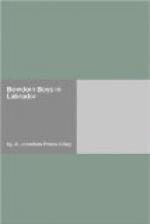The course of the river is southeast. This branch course is from the northwest. The main stream turns off sharply to the northeast and after a few miles passes into a deep canon, christened “Bowdoin Canon,” between precipitous walls of archeac rock from six hundred to eight hundred feet high. This canon was afterward found to be about twenty-five miles long and winding in its course. In but few places is the slope such as to permit a descent to the river bank proper, and the canon is so narrow, and the walls of such perpendicular character, as to make the river invisible from a short distance. It might truly be said that the discovery of this canon, infinitely grander on account of its age than any other known to geology, and surpassed by few in size, is the most important result of the expedition. Several photographs of it were made, which were not injured by the exposure to wet and rough usage that the camera had to receive during the return journey, and alone convey an adequate idea of this most wonderful of nature’s wonders.
At night the first camp away from the river was made, on the plateau. The two men felt that the next day must be their last of advance, so weakened were they by the terrible tramping over deep moss and the persistent bleeding by black flies. The stock of provisions, too, was running low, and with their diminishing strength was a warning to turn back that could not be neglected. A half dozen grouse, three Canada and three rough, had been added to their supplies, but even with full meals they could not long stand the double drain upon their strength.
In the morning a high hill was seen, for which they started, drawing slightly away from the river. Soon a roar from the direction of the river was noticed, which differed from the ordinary roar of the rapids. Altering their course it was found the roar “kept away,” indicating an unusually heavy sound. Pushing forward, thinking it must be the desired falls, they soon came out upon the river bank, with the water at their level. This proved the falls to be below them, and looking down they could be seen “smoking” about a mile distant. A distinct pounding had also been felt for some time previous, which further assured them that the falls were at hand. The roar that had attracted their attention was of the river running at the plateau level. At the point they came out upon it, it was nearly two hundred yards wide, a heavy boiling rapid. Walking down the great blocks of rock which form the shore, the river appeared to narrow and at 11.45 A.M., the Grand Falls were first seen.




